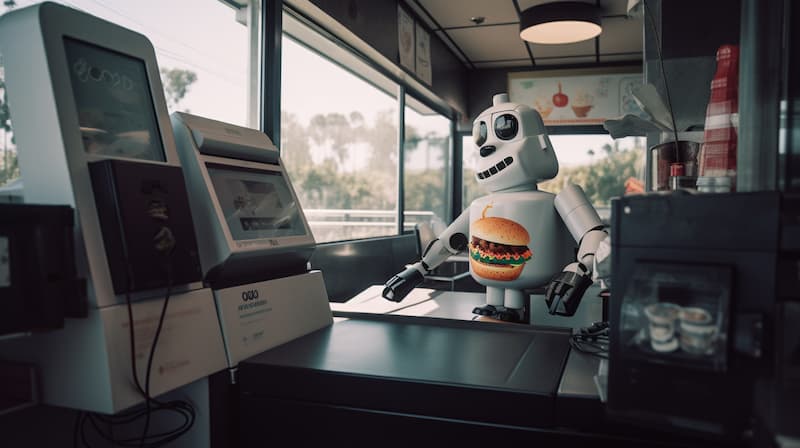Wendy's, the popular fast-food chain, is set to automate its drive-through service by deploying an artificial intelligence (AI) chatbot powered by Google's natural-language software. This move positions Wendy's among the growing number of companies utilizing generative AI to enhance business growth.
Efficient Ordering and Improved Customer Experience
The primary objective of implementing the AI chatbot is to streamline the ordering process and prevent long queues in the drive-through lanes, which can deter potential customers. Wendy's CEO, Todd Penegor, emphasized that the chatbot would be conversational and indistinguishable from a human employee. The chatbot will officially launch in June at a company-owned restaurant in Columbus, Ohio.
Collaboration with Google and Generative AI
To create a seamless and conversational chatbot, Wendy's software engineers have been working closely with Google to develop a generative AI application built on top of Google's large language model (LLM). The LLM is an extensive algorithmic software tool loaded with words, phrases, and popular expressions in various dialects and accents, designed to recognize and mimic human speech. Generative AI tools, like the one used for Wendy's chatbot, are engineered to generate natural-language responses, images, or computer code based on user text prompts.
Unique Terminology and Challenging AI Implementation
Wendy's customized language model incorporates unique terms, phrases, and acronyms that customers use when ordering, such as "JBC" for junior bacon cheeseburger or "biggie bags" for specific combinations of food items. The model also considers the branded term for Wendy's milkshakes, "Frosties," which customers might not always use. According to Thomas Kurian, CEO of Google Cloud, implementing AI in a drive-through setting is more complicated than it appears, as the software must overcome extraneous noise and adapt to customers' changeable orders.
Upselling and Impact on Service Speed
The AI application is programmed to upsell customers by offering larger sizes, Frosties, or daily specials. Once the chatbot takes an order, it appears on a screen for line cooks, and meals are then relayed to the pickup window. Wendy's CIO, Kevin Vasconi, reported that recent test runs at the Columbus restaurant showed favorable results, with the chatbot performing on par with their best customer service representatives. The technology aims to improve service speed and consistency.
Drive-Through Sales and Growth Strategy
Wendy's drive-through lanes account for up to 80% of food orders, a significant increase from the pre-pandemic rate of approximately two-thirds. The goal is to expedite the drive-through process, boosting sales for every minute saved. In March, Wendy's announced a restructuring plan focused on systemwide sales growth, aiming to maintain general and administrative costs while increasing global sales.
AI Market Outlook
According to market analytics firm PitchBook Data, spending in the global generative AI market is projected to reach $42.6 billion by the end of the year, with a compound annual growth rate of 32%, amounting to $98.1 billion by 2026. Wendy's adoption of AI technology for its drive-through service is a testament to the increasing role of AI in enhancing customer experiences and driving business growth.
Not a Replacement for Human Workers
It is essential to note that the deployment of the AI-driven chatbot at Wendy's drive-throughs is not intended to replace human workers. CEO Todd Penegor stated that the new technology aims to assist employees by handling many manual tasks involved in taking drive-through orders. This approach will enable workers to focus on other aspects of customer service and food preparation, improving overall efficiency and customer satisfaction.
Franchisee Adoption and Expansion
The pilot rollout of the AI chatbot also seeks to demonstrate to Wendy's franchisees that the technology works and can enhance service speed and consistency. A successful implementation in the Columbus restaurant could pave the way for broader adoption across Wendy's locations, leading to a more uniform and efficient customer experience throughout the fast-food chain.
Competitive Advantage and Industry Trend
Wendy's adoption of AI-powered chatbots for drive-through service is a strategic move that could give the company a competitive edge in the fast-food industry. As more businesses recognize the potential of AI to streamline operations and improve customer experiences, Wendy's early adoption of this technology positions it as an innovator and leader in the field. Furthermore, the collaboration with Google ensures access to state-of-the-art AI technology and expertise, increasing the likelihood of successful implementation.
Challenges and Future Prospects
While the introduction of AI chatbots at Wendy's drive-throughs promises numerous benefits, it also presents challenges that need to be addressed. Ensuring that the chatbot can handle a wide range of accents, dialects, and unique ordering terminology is essential for delivering a seamless customer experience. Additionally, addressing potential privacy and data security concerns associated with using AI technology will be crucial for maintaining customer trust.
Takeaway
Wendy's AI-powered drive-through automation has the potential to transform the fast-food industry by streamlining the ordering process and enhancing customer experiences. By overcoming challenges and capitalizing on the growing generative AI market, Wendy's can position itself as a frontrunner in the implementation of cutting-edge technology and drive further growth in the coming years.







